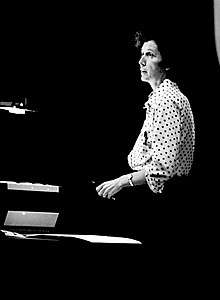Helen T. Edwards
Helen Thom Edwards (May 27, 1936 – June 21, 2016) was an American physicist.[1] She was the lead scientist for the design and construction of the Tevatron at the Fermi National Accelerator Laboratory.[2][3] "She knew how to bring the right people together to carry out a project and how to encourage them to success. In private life, she was a nature lover and is remembered as a very gentle and caring person."[4]
Helen T. Edwards | |
|---|---|
 Physicist Helen Edwards speaking at the 12th International Conference on High-Energy Accelerators at Fermilab on August 14, 1983 | |
| Born | May 27, 1936 |
| Died | June 21, 2016 (aged 80) |
| Alma mater | Cornell University |
| Awards | E. O. Lawrence Award (1986) MacArthur Foundation Fellowship, National Medal of Technology |
| Scientific career | |
| Fields | Accelerator physics |
| Institutions | Fermi National Accelerator Laboratory |
Career
Edwards was best known for leadership in the design, construction, commissioning and operation of the Tevatron, which for 25 years was the most powerful particle collider in the world. Tevatron recorded its first proton-antiproton collisions in 1985 and was used to find the top quark in 1995 and the tau neutrino in 2000, two of the three fundamental particles discovered at Fermilab. Between 1989-92, Edwards was also deeply involved in the eventually abandoned project of the Superconducting Super Collider in Texas.
After 1992, Edwards made significant contributions to the development of high-gradient, superconducting linear accelerators as well as bright and intense electron sources. She played a key role working with scientists at DESY developing superconducting accelerator technology.[5] She led a Fermilab group collaborating with DESY in the 1990s and built the photoinjector for the TESLA Test Facility at the German laboratory. Fermilab has since developed superconducting accelerator technology to the point that it is the enabling technology behind its future proton accelerators. [6]
Education
- The Madeira School 1953
- Cornell University 1957-1966
Edwards earned a bachelor's degree in physics from Cornell University. After her undergraduate work, she continued studying at Cornell University, where she earned her M.S. degree in the physics department under Kenneth Greisen working with the development of electromagnetic showers. Edwards eventually earned her PhD from Cornell in 1966, working under the direction of Boyce McDaniel in the Laboratory of Nuclear Studies.
Positions
After earning her PhD at Cornell in 1966, Edwards continued her work in Nuclear Studies at Cornell as a research associate at the 10 GEV Electron Synchrotron[7] under the supervision of Robert R. Wilson. Edwards then joined Wilson when he transitioned to Fermi National Accelerator Laboratory in 1970.
When she first began her work at Fermilab, she was put in charge of the accelerator division. In her most well-known work, she oversaw the building of the Tevatron, one of the highest energy super-conducting particle accelerators ever constructed. Her work was supervised by Leon M. Lederman.
- 1966-70 Research Associate, 10 GEV Electron Synchrotron, Cornell University
- 1970-87 Associate Head of the Booster Group, Fermi National Accelerator Laboratory
- 1987-89 Head, Accelerator Division, Fermi National Accelerator Laboratory
- 1989-92 Head & Associate Director, Superconducting Division, Superconducting Super Collider Laboratory, Dallas
- 1988 MacArthur Fellow
- 1992–2010 Guest Scientist, Fermi National Accelerator Laboratory
Awards and Honors
- Robert R. Wilson Prize for Achievement in the Physics of Particle Accelerators Recipient from the American Physical Society (2003)
- USPAS Prize for Achievement in Accelerator Physics and Technology 1985[8]
- E. O. Lawrence Award, U.S. Department of Energy 1986[9]
- MacArthur Foundation Fellowship 1988[10]
- Elected to the National Academy of Engineering (1988)
- National Medal of Technology 1989[11]
References
- "Helen T. Edwards — MacArthur Foundation". macfound.org. Retrieved 4 November 2016.
- "The Shutdown Process". Tevatron Home. Fermi National Accelerator Laboratory. Retrieved 12 October 2013.
- "Helen Edwards, visionary behind Fermilab's Tevatron, dies". fnal.gov. 27 June 2016. Retrieved 4 November 2016.
- "Helen T. Edwards, 1936-2016". IEEE.
- "DESY mourns Helen Edwards". DESY. DESY. Retrieved 1 May 2019.
- "Proton Improvement Plan-II". Fermilab. Fermilab. Retrieved 1 May 2019.
- Mcdaniel, Boyce; Albert Silverman (October 1968). "The 10‐GeV synchrotron at Cornell". Physics Today. 21 (10): 29–38. Bibcode:1968PhT....21j..29M. doi:10.1063/1.3034533.
- "USPAS Prize for Achievement in Accelerator Physics and Technology". United States Particle Accelerator School. Fermi National Accelerator Laboratory. Retrieved 12 October 2013.
- "Helen T. Edwards, 1986". The Ernest Orlando Lawrence Award. U.S. Department of Energy. Retrieved 12 October 2013.
- "Meet the 1988 MacArthur Fellows". MacArthur Foundation. John D. and Catherine T. MacArthur Foundation. Retrieved 12 October 2013.
- "2003 Robert R. Wilson Prize for Achievement in the Physics of Particle Accelerators Recipient". American Physical Society Sites. American Physical Society. Retrieved 12 October 2013.
Further reading
- Anderson, Olga (1995). "Helen T. Edwards". In McMurray, Emily J.; Kosek, Jane Kelly; Valade III, Roger M. (eds.). Notable twentieth-century scientists. Detroit, MI: Gale Research. ISBN 978-0810391819.
- Lanam, Richard D. (1994). American Men and Women of Science, 1995-96. New Providence, NJ: R.R. Bowker. ISBN 978-0835234634. Retrieved 12 October 2013.
- Oakes, Elizabeth H. (2007). Encyclopedia of World Scientists. Infobase Publishing. p. 202. ISBN 9781438118826. Retrieved 12 Oct 2013.
- Pellegrini, Claudio. "Helen Thom Edwards". Contributions of 20th Century Women to Physics. University of California. Archived from the original on 6 August 2013. Retrieved 12 October 2013.
- Peoples, John (2006). Out of the Shadows: Contributions of Twentieth-Century Women to Physics. Cambridge University Press. ISBN 978-0-521-82197-1.
- Savage, Darin C. (1997). "Helen T. Edwards". In Shearer, Benjamin F. (ed.). Notable women in the physical sciences : a biographical dictionary (1. publ. ed.). Westport, Conn.: Greenwood Press. pp. 80–?. ISBN 9780313293030.
- Link to image of Helen T. Edwards